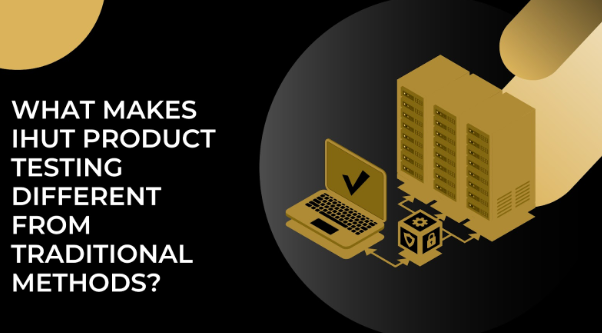What Makes IHUT Product Testing Different From Traditional Methods?

In the ever-evolving landscape of product development, companies constantly seek effective ways to understand consumer preferences. In this quest, traditional methods of product testing have long been the norm.
However, a new player has entered the scene, bringing a fresh perspective and a promise of deeper insights – IHUT Product Testing. But what exactly sets IHUT apart from the traditional methods we’re accustomed to?
The Basics of Product Testing: A Quick Overview
Before we delve into the differences, let’s establish a common ground. Traditional product testing usually involves gathering a group of individuals, known as a focus group, and having them try out a new product. Their feedback is collected through surveys, interviews, or observation. It’s a straightforward approach, Is this the most effective?
Traditional Product Testing
In the realm of traditional product testing, the emphasis is often on the controlled environment. Test subjects are brought into a designated space, handed the product, and their experiences are observed in a somewhat artificial setting. Although this method provides valuable data, it may lack the real-world context crucial for understanding how a product truly performs.
The Limitations of Tradition: The Need for Change
Artificial Environments and Unrealistic Settings
Traditional methods, by their very nature, confine the testing experience to a controlled environment. This controlled environment might not mirror the situations where consumers typically use a product. For instance, testing a new shampoo in a sterile room doesn’t capture the nuances of a bustling morning routine.
Limited Timeframe for Evaluation
Traditional product testing often operates within a constrained timeframe. This limitation can impact the depth and accuracy of feedback, as users may need more time to comprehend the product’s long-term effects.
IHUT: Bringing Products Into the Heart of Homes
Real-World Context: Testing in the Natural Habitat
Unlike traditional methods, IHUT product testing puts products in the hands of consumers within the comfort of their homes. This real-world context is invaluable, as it allows users to incorporate the product seamlessly into their daily routines.
Extended Trial Periods: Understanding Long-term Impact
IHUT allows for an extended trial period, addressing time constraints faced by traditional testing. This extended interaction enables users to evaluate products over an extended period, providing a more comprehensive understanding of their impact.
Genuine User Experience: A Human Touch
The beauty of IHUT lies in its ability to capture genuine user experiences. Products are tested during real-life situations, offering a nuanced understanding of how they fit into the lives of consumers. This human touch adds depth to the feedback and helps companies tailor their products to meet genuine needs.
Making the Choice: Traditional vs. IHUT
Cost-Effectiveness
In terms of cost-effectiveness, traditional methods may have an edge initially. However, when considering the long-term benefits of IHUT’s in-depth insights and potential for higher consumer satisfaction, the scales may tip in favor of the latter.
Time Efficiency
While traditional methods boast a quick turnaround, IHUTs allow for the ability to gather data over a more extended period can provide a more comprehensive understanding of a product’s performance. It’s a trade-off between speed and depth.
Consumer Engagement
IHUT shines when it comes to consumer engagement. Placing products directly into the homes of users fosters a stronger connection, making them active participants in the product development process. Traditional testing, with its controlled settings, may not elicit the same level of involvement.
Advantages of IHUT Over Traditional Methods
While lab testing assesses products in controlled settings, IHUT testing removes limitations by sending items directly to potential buyers’ homes. This crucial distinction underscores the clear advantages of IHUT over traditional techniques:
- Realism – In familiar environments, testers provide candid feedback reflective of real-world conditions. Without simulated exam settings, IHUT offers true-to-life findings.
- Versatility – Applicable across product categories, IHUT handles everything from small appliances to electronics. It also works for goods still in development, making it a proven concept-testing model.
- Ecosystem Integration – By experiencing items in their ecosystems, testers evaluate complementary and secondary use cases. This holistic perspective surpasses narrow lab assessments.
- Scalability – With streamlined recruitment and remote coordination, IHUT seamlessly scales to large groups without geographic constraints. This enables nationally representative samples unachievable through in-facility testing.
Through these enhanced capacities, IHUT testing provides multidimensional insights that guide strategic optimization. Superior accuracy in predicting satisfaction and market success allows IHUT to shape development cycles for maximum ROI.
Implementing IHUT for Effective Product Development
IHUTs yield realistic findings on product satisfaction, usage, and potential improvement areas, crucial for final product inspection before launch. IHUTs involve sending products to selected participants’ homes and collecting feedback through various methods, including online surveys.
Once the criteria for participant selection are set and the product is in the hands of real users, the insights begin to flow. These insights are not just numbers; they’re the stories of products like low and no-alcohol beverages, which saw a sales increase of over 20.5 percent thanks to IHUT.
Final Thoughts
Both traditional product testing and IHUT have their strengths and limitations. The ideal approach might be a blend of these methods, leveraging the quick insights of traditional testing and the depth of understanding offered by IHUT.
Striking this balance could be the key to unlocking the full potential of product testing in the dynamic landscape of consumer preferences. As the market continues to evolve, so too must the methods employed by companies to understand and meet the needs of their consumers.
IHUT represents a significant step forward, injecting a human touch and real-world context into the product testing process. It’s not about replacing the old with the new but finding a harmonious blend that propels product development into a more consumer-centric future.
FAQs
How does IHUT ensure unbiased feedback from participants?
IHUTs place products directly into the hands of potential users, allowing companies to gather authentic feedback in a natural setting. Unbiased responses come from the everyday, real-world usage.
What types of products are best suited for IHUT testing?
IHUTS are suitable for a wide range of products, including health and beauty aids, cleaning products, tools, appliances, and foods used in different recipes. The versatility allows it to be applied across industries.
How does IHUT handle the logistics of product distribution and data collection?
Streamlined processes enabled by technology allow for efficient operations in distributing products and collecting participant feedback. Robust platforms help manage contactless delivery, remote user testing, and big data consolidation.



